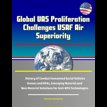Global UAS Proliferation Challenges USAF Air Superiority: History of Combat Unmanned Aerial Vehicles, Drones and RPAs, Emerging Material and Non-Material Solutions for Anti-RPA Technologies
Global UAS Proliferation Challenges USAF Air Superiority: History of Combat Unmanned Aerial Vehicles, Drones and RPAs, Emerging Material and Non-Material Solutions for Anti-RPA Technologies
€ 4,60
This report has been professionally converted for accurate flowing-text e-book format reproduction. Remotely piloted aircraft (RPA) have been under development with intent for use in a military environment for almost 100 years. For the majority of that time period, RPA complexity, size, cost, logistical and handling requirements have made them cumbersome and difficult to use dissuading most nations from pursuing them as a viable capability. However, dramatic improvements in technology over the last two decades have allowed for a decrease in size, cost, and complexity while increasing capability. As a result, proliferation of small inexpensive RPAs has occurred on a global scale making them available for nation states and non-state actors to procure. Lightweight RPAs present a threat to USAF contingency operations. To maintain air superiority the USAF must recognize inexpensive RPA proliferation is currently unchecked, the threats they present, and pursue material and non-material solutions to defeat these threats. This paper provides a short review of the history, development, and use of combat RPAs, highlights RPA proliferation and threat, explores emerging anti-RPA technologies and recommends material and non-material solutions to address the threat.
This compilation includes a reproduction of the 2019 Worldwide Threat Assessment of the U.S. Intelligence Community.
The United States has retained air superiority in every conflict it has participated since the conclusion of the Vietnam War. No U.S. ground forces have been killed in combat by a foreign airpower since the Korean War. The U.S. monopoly on airpower, however, is rapidly coming to a close with increasing global proliferation of inexpensive Remotely Piloted Aircraft (RPA). While the United States Air Force's (USAF) offensive Unmanned Aerial Systems (UAS) capability is unmatched, its defensive UAS capability is under developed, jeopardizing the USAF's ability to provide air superiority during contingency operations. The next evolution in aviation extends beyond the large multi-million dollar drone highlighted on the nightly news to the easily acquired RPA. Ease of access coupled with intent could lead to state and non-state actors using inexpensive RPAs against our nation. The USAF has little ability to defend against them as existing conventional radars and armaments are designed to detect and defeat large aircraft. To maintain air superiority the USAF must recognize inexpensive UAS proliferation is unchecked, the threats they present, and pursue material and non-material technologies and capabilities to defeat these threats. Low cost RPA technology has flooded the commercial market. Widespread Internet access provides means to purchase sub-components or a fully assembled, ready-to-fly unit. Small RPAs are defined as an asset with a wingspan or rotor-blade diameter less than six feet, can be concealed within the confines of a vehicle, suitcase or backpack, costs less than $25K, and can be operated by one person with no formal training.
This report has been professionally converted for accurate flowing-text e-book format reproduction. Remotely piloted aircraft (RPA) have been under development with intent for use in a military environment for almost 100 years. For the majority of that time period, RPA complexity, size, cost, logistical and handling requirements have made them cumbersome and difficult to use dissuading most nations from pursuing them as a viable capability. However, dramatic improvements in technology over the last two decades have allowed for a decrease in size, cost, and complexity while increasing capability. As a result, proliferation of small inexpensive RPAs has occurred on a global scale making them available for nation states and non-state actors to procure. Lightweight RPAs present a threat to USAF contingency operations. To maintain air superiority the USAF must recognize inexpensive RPA proliferation is currently unchecked, the threats they present, and pursue material and non-material solutions to defeat these threats. This paper provides a short review of the history, development, and use of combat RPAs, highlights RPA proliferation and threat, explores emerging anti-RPA technologies and recommends material and non-material solutions to address the threat.
This compilation includes a reproduction of the 2019 Worldwide Threat Assessment of the U.S. Intelligence Community.
The United States has retained air superiority in every conflict it has participated since the conclusion of the Vietnam War. No U.S. ground forces have been killed in combat by a foreign airpower since the Korean War. The U.S. monopoly on airpower, however, is rapidly coming to a close with increasing global proliferation of inexpensive Remotely Piloted Aircraft (RPA). While the United States Air Force's (USAF) offensive Unmanned Aerial Systems (UAS) capability is unmatched, its defensive UAS capability is under developed, jeopardizing the USAF's ability to provide air superiority during contingency operations. The next evolution in aviation extends beyond the large multi-million dollar drone highlighted on the nightly news to the easily acquired RPA. Ease of access coupled with intent could lead to state and non-state actors using inexpensive RPAs against our nation. The USAF has little ability to defend against them as existing conventional radars and armaments are designed to detect and defeat large aircraft. To maintain air superiority the USAF must recognize inexpensive UAS proliferation is unchecked, the threats they present, and pursue material and non-material technologies and capabilities to defeat these threats. Low cost RPA technology has flooded the commercial market. Widespread Internet access provides means to purchase sub-components or a fully assembled, ready-to-fly unit. Small RPAs are defined as an asset with a wingspan or rotor-blade diameter less than six feet, can be concealed within the confines of a vehicle, suitcase or backpack, costs less than $25K, and can be operated by one person with no formal training.
| Prijs | Verzendkosten | Totaal | |
|---|---|---|---|
€ 4,60 | € 0,00 | € 4,60 |
Alternatieve producten
© 2016 - 2024 aanbiedingchecker

